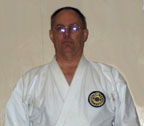
Karate Web Dojo
an online service of the Nippon Karate-do/Kobudo Seishin-Kan


Who is Pellman Sensei?
Leonard J. Pellman is the founder and chief instructor (Dojo-Cho) of the Seishin-Kan, a member dojo of the Jikishin-Kai. He is also one of the senior disciples of Shimabukuro Masayuki Shihan, under whom he has trained since 1989.
Pellman Sensei began his martial arts journey in 1966. After pleading with his parents for two years to enroll him in a karate program, he was allowed to join the San Diego School of Judo and Jujitsu, where he studied under the legendary Al Holtman Sensei for nearly three years and achieved the rank of sankyu. Still, karate remained his first love. "I used to tell my friends I was a karate-ka, instead of a judo-ka," Pellman Sensei now admits, "Because that's what I really wanted to be. I knew a few atemi-waza (striking techniques) from judo, and could throw my friends like rag-dolls, so most of them believed me . . . I think."
In 1968 he was selected from more than 300 applicants to go to Japan as an exchange student in his junior year of high school. There, while staying with a family who could trace their ancestry to samurai on both the father's and mother's sides, he attended Toyokawa High School. Both judo and kendo were part of the high school physical education curriculum, so he received additional tutelage daily. As Pellman Sensei remembers, "I was nearly six feet tall and blond-haired, so I really stood out as a gaijin (foreigner), and my fellow students took exceptional joy in throwing me soundly during judo practice and beating me mercilessly with shinai (bamboo swords) in kendo. Taking my beatings good-naturedly earned me a good measure of respect among my fellow students, and was actually some of my best martial arts training."
While in Japan, he was able to visit a small Shotokan dojo in nearby Toyohashi on occasion, but this small taste of karate-do only served to whet his apetite. After returning from Japan, he graduated high school and attended Mesa Junior College (now called a "community college") for a year before transferring to San Diego State University. At SDSU, he first took fencing for a semester, competing in foil and saber, then finally fulfilled his seven-year ambition by enrolling in the college karate program in January 1971. It was the beginning of his 30-year love affair with the art of karate-do.
"The SDSU program was actually Tang Soo Do, and was taught by Lee Jong Hyun Sabumnim," Pellman explains, "One of the true pioneers of Tang Soo Do. Master Lee began him training in 1952 (only seven years after Tang Soo Do was founded) under Hong Jong Soo Kyosanim, who would eventually rise to become president of the Kukkiwon -- now the official Korean governing body of Taekwondo. In those days, the leaders of fledgling Tang Soo Do and Kong Soo Do (the forerunner of Taekwondo) in Korea were mostly former Shotokan students, so the hyung (kata) that Master Lee taught were essentially the same as Shotokan kata. Kicho Hyung Il-bu is the same as Taikyoku Shodan, Pyongan (Pinan) Cho-dan, Yi-dan, Sam-dan, Sa-dan, and O-dan are nearly identical to Heian Shodan, Nidan, Sandan, Yondan, and Godan -- even down to the names of Heian Shodan and Heian Nidan being switched, as they are in Shotokan. After Hong Jong Soo Kyosanim switched allegiance to Taekwondo, Master Lee became a direct disciple of Tang Soo Do's founder, Hwang Kee. In the early '60s, Master Lee was one of the original seven masters sent by Hwang Kee to spread Tang Soo Do to the United States and was assigned all of California as his territory."
In June, 1973, after graduating from SDSU with a Bachelor of Science degree in Marketing (Pellman Sensei calls it a "BS in BS-ing"), Pellman Sensei returned to Japan for another stay as an uchi-deshi (live-in student). The principal focus of this trip was his martial arts training, which included aikido, kendo, and Shotokan karate-do. While there, the eldest daughter of his host family got married (to his aikido instructor). At the wedding, her uncle performed a demonstration of iaido -- a common performance at a traditional Japanese wedding. "I was spellbound," Pellman Sensei recalls, "He was so smooth and precise with each draw and cut . . . so intensely focused . . . and so obviously deadly. I immediately knew that I must someday learn iaido. But after watching his performance," Pellman now admits, "I was so terrified that I couldn't work up the courage to ask him for lessons in case he took it as an insult coming from a foreigner." The shortage of jet fuel brought on by the OPEC oil embargo forced Pellman Sensei to return to the US in late December, 1973 after completing only half the training he had planned.
Master Lee died of stomach cancer in 1985, and his organization was splintered when several of his senior students broke away to establish dojang of their own. For awhile, Pellman Sensei continued his training under Master Lee's most senior student, Michael Conniry. Then, in 1988, he was introduced to Shimabukuro Masayuki Shihan, and Pellman Sensei took his first step onto a new path.
To follow Pellman
Sensei down this new path,
click here![]() to go to the next page--
to go to the next page--
Home | Membership | Privacy Policy | Webmaster | Contact Us | Guest Book | JKI Home | Store
© 2003 Leonard J. Pellman